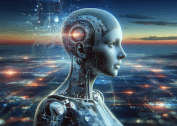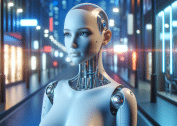Artificial intelligence is no longer just the realm of sci-fi; it is part of daily routines for millions. This article explores how AI is changing personal technology, home life, and work, helping you see where this smart tech fits in and what its evolution could bring next.
AI Integration in Daily Devices
Phones, watches, and home gadgets are now powered by artificial intelligence. Voice assistants respond to commands, learning accents and preferences over time. A simple request like ‘play music’ activates sophisticated neural networks that sort through millions of files. This hands-free approach is fast becoming standard, and the technology stays helpful even as needs change. From setting reminders to suggesting driving routes, AI adjusts to each individual.
Many household devices—such as smart thermostats and lighting—also rely on intelligent algorithms. As users make choices, these systems adapt, creating personalized environments that anticipate comfort. The growth of these tools reflects an era where seamless digital experience is in demand. AI in personal devices has progressed to read text on images and recognize objects, making life easier for users with visual impairments or busy schedules.
The shift toward interconnected smart devices transforms ordinary routines. Whether monitoring fitness or controlling security systems, people now rely on AI to handle tasks once considered tedious. These advancements are not just conveniences; they point to a world where digital intelligence is a constant companion, quietly helping behind the scenes.
Voice recognition is a prime example of AI’s adaptation. These systems constantly analyze spoken input, improving their ability to understand and predict user intent. This makes conversations with digital assistants clearer, whether the focus is sending a message or answering a trivia question. The underlying technology relies on machine learning, a branch of artificial intelligence that gets better as more data is processed.
Language models make translating, dictating, and answering questions possible in real time. This efficiency allows users to save time, increasing workplace productivity and simplifying home tasks. Beyond convenience, language models also help bridge gaps for people with disabilities, turning spoken words into written text or controlling devices through speech alone.
AI’s learning capability is especially visible in music and movie recommendations. The more movies watched or songs played, the smarter these engines become at guessing taste. This personalized approach to entertainment means that home streaming platforms can feel uniquely tailored to every household member.
Machine learning doesn’t just help users; it empowers devices to anticipate problems. Cameras with AI detect delivery packages and send alerts only when relevant. Some refrigerators recommend recipes based on what is inside, reducing food waste and encouraging healthier cooking options. As these systems gather data, their accuracy improves.
Security remains a prime focus for AI engineers. Algorithms are built to identify suspicious activity, reducing false alarms and streamlining emergency responses. Smart doorbells, powered by real-time image analysis, add an extra layer of safety.
This hands-on AI marks a major transformation in daily life. People benefit from having more time and fewer routine worries. While concerns about privacy and bias exist, advances in this technology are making everyday experiences not just easier but also more enjoyable.
Personalized Experiences Powered by AI
Personalization is where artificial intelligence truly shines. Users now expect their content, suggestions, and online searches to fit their lives closely. Streaming services employ sophisticated recommendation engines that sort through vast libraries to surface shows or music closely aligned with individual interests.
Learning algorithms keep track of viewing history, rating trends, and even the time of day someone prefers certain genres. These AI-driven preferences allow platforms to adapt over time, meaning more accurate and relevant options for users. By continuously refining recommendations, these engines help reduce choice fatigue, making it easier to discover new favorites.
AI-driven personalization goes beyond entertainment. Online retailers use machine learning to offer precise product suggestions. The more a user interacts with a site, the better the system becomes at identifying likely needs or preferences—whether that’s in clothing, technology, or even grocery delivery.
Customizing communications is another area where AI excels. Email services automatically filter spam and sort important messages to the top, based on patterns in reading and replying behavior. This decreases clutter and ensures crucial messages are easier to find. Search engines tweak results with each query, quietly learning from every interaction to improve future performance.
Some platforms even experiment with AI to balance digital overload. Web browsers and news aggregators now curate feeds based on reading habits and time spent on articles, trying to create a more satisfying online experience.
The goal is to make technology feel more like a helpful friend than a pushy salesperson. As a direct result, engagement rates climb—users spend more time with tailored content and less time searching for what they want.
Financial wellness apps also use AI to analyze spending and offer customized advice. By monitoring everyday transactions, these platforms provide insights about budgeting, investments, and savings goals. Some even suggest changes to recurring bills, detecting trends and anomalies that might be missed by human eyes.
This kind of personalized experience is leading to a new standard in technological interactions. People become accustomed to immediate relevance and subtle, behind-the-scenes adjustments. In the near future, even more AI-powered tools promise to go further—anticipating needs before users are even aware of them.
But there’s a balance: as personalization deepens, concerns about data privacy become more pronounced. The evolution of these experiences will depend on transparent practices and careful regulation, ensuring users remain in control of their information.
Artificial Intelligence in Education and Learning
AI is rapidly reshaping the classroom. Digital tutors adjust questions and explanations based on each student’s understanding, helping bridge gaps in comprehension. These tools use real-time data to fine-tune lessons, supporting learners in a personalized way.
Advanced educational apps track how quickly topics are grasped and which concepts pose particular challenges. The result: adaptive learning systems that stretch high-performing students while lending extra support to others. This one-on-one approach was once only possible with dedicated tutors, but machine intelligence is making customized learning widely accessible.
Language teaching apps powered by artificial intelligence detect pronunciation and grammar errors. They offer corrections instantly, making practice more interactive. Using speech recognition and natural language processing, these platforms give feedback that can accelerate language acquisition for learners of all ages.
AI-aided grading is also beginning to take hold. Instead of manual review, some tests and written responses are checked by algorithms trained on thousands of correct and incorrect answers. This speeds up feedback, allowing educators to focus on teaching.
Adaptive quiz engines get smarter as they encounter more student answers, refining their evaluation with each submission. Students benefit by seeing strengths and weaknesses immediately, which can inform how they approach studying.
In higher education and corporate training, AI-driven analytics help institutions understand student outcomes. Insights from big data guide curriculum updates, teaching methods, and support systems. This data-driven approach means the educational process can continuously evolve and improve, responding in real time to what learners need.
The spread of AI in education extends far beyond formal classrooms. Online learning platforms rely on AI to curate recommended courses and create tailored study plans. Lifelong learners take advantage of chatbots that can answer questions, clarify confusing concepts, or suggest resources. The flexibility and responsiveness of artificial intelligence mean that anyone, anywhere, can shape their learning journey.
There is still a need to address issues of bias in training data, especially as AI tools reach more diverse audiences. Organizations and tech firms are actively working to ensure their algorithms perform equitably for everyone.
With careful design and ongoing oversight, AI stands to make high-quality, adaptive education the global norm. As more breakthroughs arise, teachers and students alike will continue to discover innovative ways that this technology enhances learning.
Healthcare’s AI-Fueled Future
Healthcare is witnessing some of the most promising uses of artificial intelligence. Diagnosis and treatment now often begin with smart algorithms that analyze vast amounts of medical data. From reading X-rays and MRIs to predicting disease outbreaks, AI systems support doctors in making more informed decisions.
These tools offer a second set of eyes—flagging anomalies, calculating risk scores, and even highlighting details that might be overlooked in fast-paced clinical settings. Particularly in radiology, machine learning can spot tiny changes across thousands of images, augmenting clinical expertise and improving accuracy over time.
Robot-assisted surgery, guided by AI, brings precision and steadiness to delicate procedures. The technology has the potential to reduce complications, shorten recovery periods, and lessen the strain on overworked healthcare professionals.
Another transformative trend is AI-powered patient monitoring. Wearable devices keep tabs on vital signs, alerting both patients and caregivers to subtle changes that may require medical attention. People with chronic conditions gain peace of mind knowing their health is under constant observation.
Some mobile apps detect irregularities like atrial fibrillation by analyzing heart rhythms through smartwatches. The early warning provided by these apps can lead to faster intervention and better long-term health outcomes.
The growth of telemedicine owes much to AI’s ability to triage symptoms, direct patients to the right resources, and automate routine follow-ups. This technology can expand access to care, particularly for those in rural or underserved areas.
Patient data privacy is a top priority for healthcare and AI developers. As more health records are digitized, robust encryption methods—many powered by artificial intelligence themselves—help secure sensitive information.
Researchers are experimenting with federated learning, where AI models get smarter by accessing distributed data without exposing any individual’s records. This innovation could open up new avenues for medical discovery while maintaining confidentiality.
These shifting practices raise new ethical questions around transparency, consent, and accountability. Regulators and practitioners are working together to ensure that advances in medical AI benefit everyone while protecting fundamental rights.
The Ethics and Challenges of Pervasive AI
With the rise of artificial intelligence in daily life, ethical questions have taken center stage. Issues like algorithmic bias and fairness demand careful consideration. AI systems can unintentionally reinforce stereotypes if trained on incomplete or unbalanced data.
Technology companies and researchers are expanding efforts to audit algorithms, checking for discriminatory outcomes and retraining models where necessary. This is an ongoing process, as transparency, explainability, and public trust will be crucial for widespread adoption.
Privacy, too, is a growing concern. The vast datasets needed for personalized experiences make protecting user information more challenging. Regulators globally are updating privacy standards, and tech giants have begun allowing users greater control over how data is collected and used.
Another challenge is ensuring jobs adapt to a world where AI handles many routine tasks. Automation creates efficiencies but requires people to develop new skills. Many educational institutions encourage lifelong learning, so people can move into roles that require human creativity, empathy, and problem-solving—traits AI currently cannot replicate.
Some organizations offer retraining programs, helping workers pivot as certain roles shift or disappear. Others invest in human-AI collaboration, blending technological capabilities with uniquely human abilities.
Preparing for this new workforce reality requires robust community discussions. It also calls for investment in education, mental health, and social support, as society adjusts to accelerated change.
Transparency is central to public trust. It is important for companies to disclose how their technology works and what data is being used. Because of this need, there is now a movement toward open-source AI models, peer-reviewed research, and community oversight.
The road ahead is complex. But the rewards for getting it right are enormous—technology that respects human values, supports privacy, and empowers people everywhere.
With balanced guidance and collaboration, artificial intelligence will continue to enrich everyday experiences while upholding the public’s trust and safety. The future feels closer every day.
References
1. Brookings Institution. (2023). Artificial Intelligence and the Future of Humans. Retrieved from https://www.brookings.edu/research/artificial-intelligence-and-the-future-of-humans/
2. National Institutes of Health. (2022). Artificial Intelligence in Healthcare. Retrieved from https://www.ncbi.nlm.nih.gov/pmc/articles/PMC7605628/
3. Stanford University. (2021). Artificial Intelligence Index Report. Retrieved from https://aiindex.stanford.edu/report/
4. Pew Research Center. (2023). AI and the Future of Learning. Retrieved from https://www.pewresearch.org/internet/2023/02/15/ai-and-the-future-of-learning/
5. World Economic Forum. (2023). Shaping the Future of Technology Governance: Artificial Intelligence and Machine Learning. Retrieved from https://www.weforum.org/platforms/shaping-the-future-of-technology-governance-artificial-intelligence-and-machine-learning/
6. MIT Computer Science and Artificial Intelligence Lab. (2021). Research on AI Ethics and Safe Deployment. Retrieved from https://www.csail.mit.edu/research/ai-ethics-and-safe-deployment











 Unlocking Secrets of Passive Income Streams
Unlocking Secrets of Passive Income Streams 

